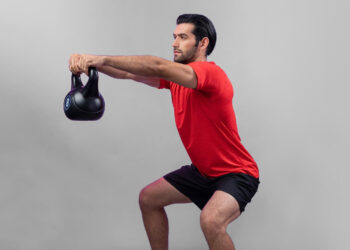How many calories do you burn to shovel snow?
The average person burn 370-715 calories in 60 minutes shoveling snow (for a 150lb person), depending on the effort put in and what tools they are using.
Using a shovel will burn more calories while using a snowblower will burn less.
How To Use the Calculator
To calculate the calories burn shoveling snow you will input the time you spend shoveling snow and how long you spent doing it in hours and minutes. Then you can select the intensity and activity of the snow shoveling you have done to find the calories you burn doing that activity.
Using the calculator step-by-step:
- Choose your unit of measurement (pounds or kilograms)
- Enter your weight
- Select the Snow Shoveling activity (Snow blower walking/pushing, Riding snow blower, Raking roof with snow rake, Snow shoveling by hand and Snow shoveling by hand with vigorous effort)
- Enter the number of minutes doing each activity
- Hit “CALCULATE”
Now you should see the approximate calories burned while shoveling snow.
MET (Metabolic Equivalent of Task)
The MET formula for calculating how many calories you burn uses what are called MET values.
Level Up Your Fitness: Join our 💪 strong community in Fitness Volt Newsletter. Get daily inspiration, expert-backed workouts, nutrition tips, the latest in strength sports, and the support you need to reach your goals. Subscribe for free!
MET values rate the calories burned from doing various physical activities. This value is a ratio between your resting metabolic rate (RMR) and your active metabolic rate (AMR).
Your resting metabolic rate is the measurement of how many calories you burn while at rest and not actively digesting. This is the same thing as your basal metabolic rate (BMR).
Your active metabolic rate is the measurement of how many calories you burn while being active throughout the day plus your resting metabolic rate.
Since MET values are the result of both your AMR and RMR, the higher a MET value, the more calories are burned. A physical activity with a MET of 1 burns as many calories as your resting metabolic rate. So, a physical activity with a MET of 5 burns 5 times as many calories as your RMR and as a physical activity with a MET of 1.
The formula also uses the oxygen used by the muscles each minute per kilogram of bodyweight. The muscles use 3.5 ml of oxygen per kilogram of bodyweight per minute. You can calculate this yourself by multiplying 3.5 by your bodyweight in kilograms.
Formula
The formula that our shoveling snow calorie calculator uses to determine the number of calories burned per minute is (MET x bodyweight in Kg x 3.5) ÷ 200.
Examples
Someone weighing 150-pounds will burn 379 calories per hour shoveling snow at a moderate effort by hand.
- Calories burned (per minute) = (body weight in kg x MET x 3.5) / 200
To calculate the calories burned by a 150-pound person, you will have an equation like this –
- (68.0389kg x 5.3 x 3.5)/200 = 6.310607975 Calories burned per minute
To find the number of calories burned shoveling snow per hour for a 150-pound person you multiply calories burned per minute by 60 minutes.
- Calories per hour burned = 6.310607975 x 60 = 379
Results
So, 379 calories are burned per hour while shoveling snow with moderate effort for a 150-pound person. 6.3 calories are burned per minute by shoveling snow.
Calories Burned with Shoveling Snow for 1 hour (weight: 150lbs)
| Type of Activity | MET | Calories Burned |
|---|---|---|
| Snow blower, walking and pushing | 2.5 | 179 |
| Riding snow blower | 3 | 214 |
| Raking roof with snow rake | 4 | 286 |
| Snow shoveling, by hand, moderate effort | 5.3 | 379 |
| Snow shoveling, by hand, vigorous effort | 7.5 | 536 |
What is Snow Shoveling?
Snow shoveling is the act of shoveling snow to usually clear an area for proper use, like a driveway, or even entire lots like schools or roads. Shoveling snow is common in areas like North America, Russia, and Europe.

Proper snow shoveling is done in steps and can be dangerous if done incorrectly. 100 deaths per year are reported from shoveling snow, so it is important to learn how to do it correctly before you try it.
Shoveling snow is a terrific exercise that is great at reducing your risk of heart attacks, heart disease, and premature death. It is one of the winter activities you can only do if it snows, so you will need to keep warm and do the task when you are fully prepared to.
Shoveling snow is great for reducing disease because it burns a lot of calories and raises the heart rate with a beneficial household chore.
How to shovel snow?
To shovel snow, first, you must dress appropriately. Wear warm clothing and loose clothing you can move around in. You will need mobility in your upper body and legs, so dress in loose but warm clothing. Stay warm!
Have the proper equipment. Snow shovels have different shapes, so buy the one(s) you need. If you are shoveling huge spaces, then buy snow pusher types, if you need to get the snow off a roof then a roof rake is just for that. Buy according to your needs.
Shoveling the snow is simple. All you do is scoop the shovel under the snow, bend your knees and grab the shovel near the blade and lift. You can then throw the snow out of the way.
Conclusion
Shoveling snow is a great exercise to not only burn many calories but also get a workout in that can reduce your risk of disease and premature death.
On snowy days you most likely can’t go to the gym or even your job. So, any exercise you can do on those days would have to be indoors or done by shoveling snow.
You can also hire someone that shovels snow if you cannot do it yourself, but if you can it is very great exercise.
Shoveling snow burns 370-715 calories per hour depending on the effort put in and what tools are used.
It is simple and beneficial to do since it is important to clear areas for communing and general travel.
If you have a habit of taking frequent breaks, and you consult with your doctor beforehand, you can shovel snow safely. You should consult with your doctor beforehand, especially if you are 45 years old or older, and if you are at risk of having heart disease or have any pre-existing medical conditions.
References:
- Snow shoveling safety: https://www.nsc.org/home-safety/tools-resources/seasonal-safety/winter/snow-shoveling
- Jetté, M., Sidney, K., & Blümchen, G. (1990). Metabolic equivalents (METS) in exercise testing, exercise prescription, and evaluation of functional capacity. Clinical cardiology, 13(8), 555–565. https://doi.org/10.1002/clc.4960130809
- WHO global recommendations on physical activity for health (updated): https://www.who.int/teams/health-promotion/physical-activity/developing-guidelines-on-physical-activity-and-sedentary-behaviour
- Compendium of physical activities: https://sites.google.com/site/compendiumofphysicalactivities/

















